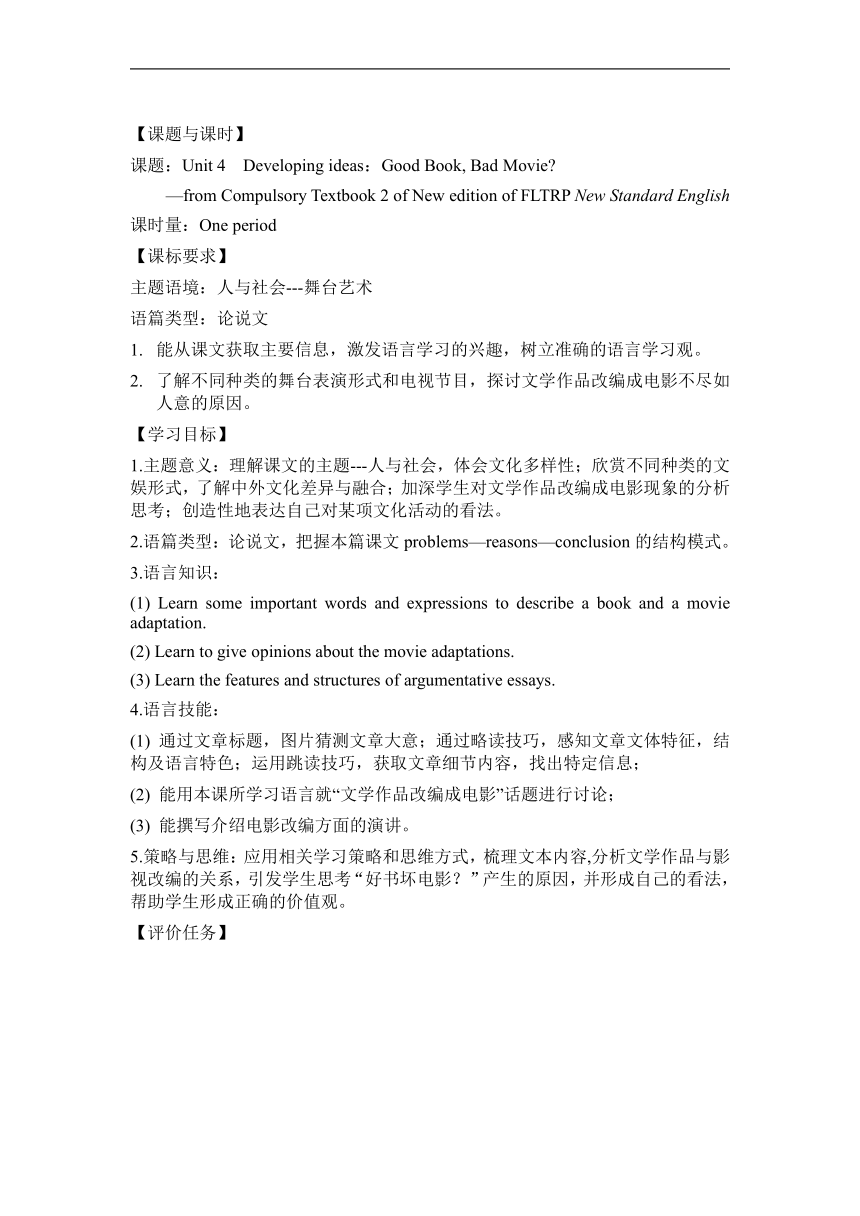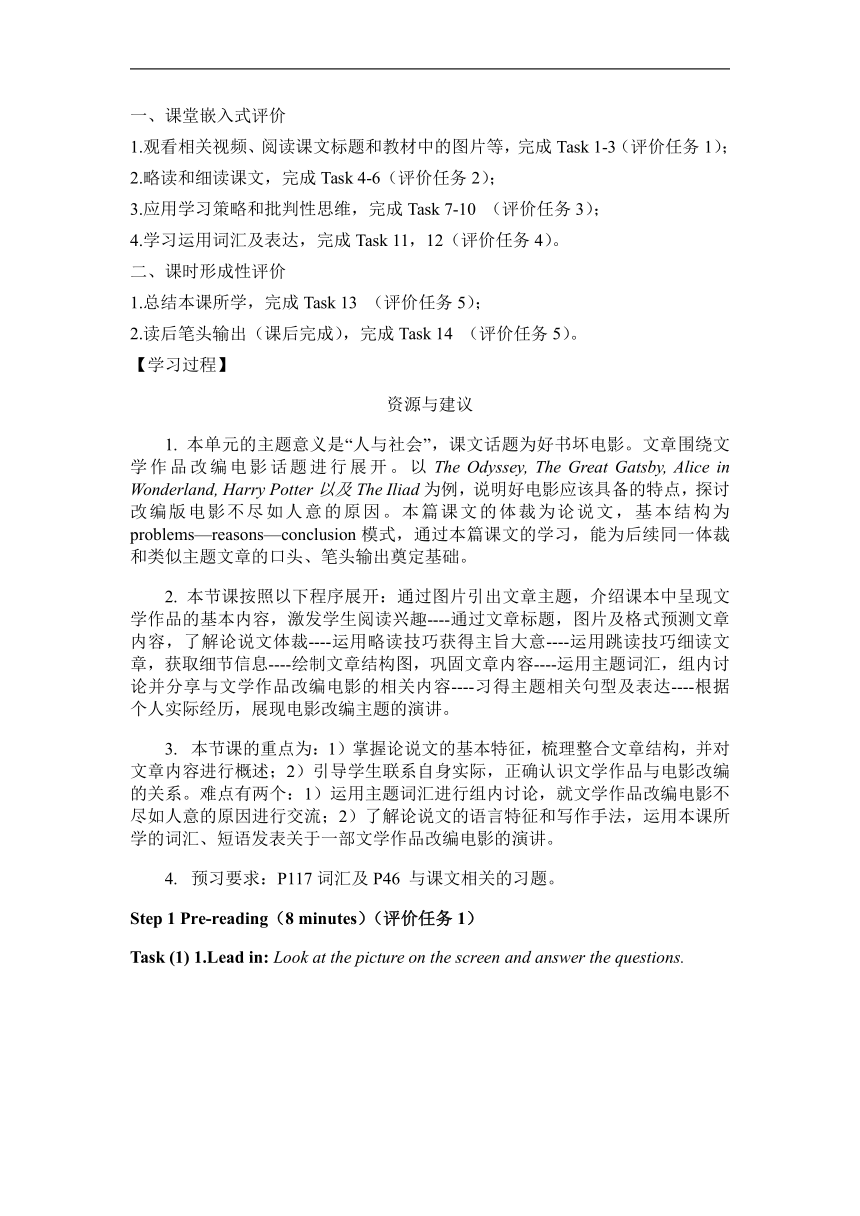外研版(2019) 选择性必修第二册 Unit 4 Breaking Boundaries Developing ideas Reading 教案-
文档属性
| 名称 | 外研版(2019) 选择性必修第二册 Unit 4 Breaking Boundaries Developing ideas Reading 教案- |  | |
| 格式 | docx | ||
| 文件大小 | 26.5KB | ||
| 资源类型 | 教案 | ||
| 版本资源 | 外研版(2019) | ||
| 科目 | 英语 | ||
| 更新时间 | 2022-10-23 23:15:08 | ||
图片预览


文档简介
【课题与课时】
课题:Unit 4 Developing ideas:Good Book, Bad Movie
—from Compulsory Textbook 2 of New edition of FLTRP New Standard English
课时量:One period
【课标要求】
主题语境:人与社会---舞台艺术
语篇类型:论说文
能从课文获取主要信息,激发语言学习的兴趣,树立准确的语言学习观。
了解不同种类的舞台表演形式和电视节目,探讨文学作品改编成电影不尽如人意的原因。
【学习目标】
1.主题意义:理解课文的主题---人与社会,体会文化多样性;欣赏不同种类的文娱形式,了解中外文化差异与融合;加深学生对文学作品改编成电影现象的分析思考;创造性地表达自己对某项文化活动的看法。
2.语篇类型:论说文,把握本篇课文problems—reasons—conclusion的结构模式。
3.语言知识:
(1) Learn some important words and expressions to describe a book and a movie adaptation.
(2) Learn to give opinions about the movie adaptations.
(3) Learn the features and structures of argumentative essays.
4.语言技能:
(1) 通过文章标题,图片猜测文章大意;通过略读技巧,感知文章文体特征,结构及语言特色;运用跳读技巧,获取文章细节内容,找出特定信息;
(2) 能用本课所学习语言就“文学作品改编成电影”话题进行讨论;
(3) 能撰写介绍电影改编方面的演讲。
5.策略与思维:应用相关学习策略和思维方式,梳理文本内容,分析文学作品与影视改编的关系,引发学生思考“好书坏电影?”产生的原因,并形成自己的看法,帮助学生形成正确的价值观。
【评价任务】
一、课堂嵌入式评价
1.观看相关视频、阅读课文标题和教材中的图片等,完成Task 1-3(评价任务1);
2.略读和细读课文,完成Task 4-6(评价任务2);
3.应用学习策略和批判性思维,完成Task 7-10 (评价任务3);
4.学习运用词汇及表达,完成Task 11,12(评价任务4)。
二、课时形成性评价
1.总结本课所学,完成Task 13 (评价任务5);
2.读后笔头输出(课后完成),完成Task 14 (评价任务5)。
【学习过程】
资源与建议
1. 本单元的主题意义是“人与社会”,课文话题为好书坏电影。文章围绕文学作品改编电影话题进行展开。以The Odyssey, The Great Gatsby, Alice in Wonderland, Harry Potter以及The Iliad为例,说明好电影应该具备的特点,探讨改编版电影不尽如人意的原因。本篇课文的体裁为论说文,基本结构为problems—reasons—conclusion模式,通过本篇课文的学习,能为后续同一体裁和类似主题文章的口头、笔头输出奠定基础。
2. 本节课按照以下程序展开:通过图片引出文章主题,介绍课本中呈现文学作品的基本内容,激发学生阅读兴趣----通过文章标题,图片及格式预测文章内容,了解论说文体裁----运用略读技巧获得主旨大意----运用跳读技巧细读文章,获取细节信息----绘制文章结构图,巩固文章内容----运用主题词汇,组内讨论并分享与文学作品改编电影的相关内容----习得主题相关句型及表达----根据个人实际经历,展现电影改编主题的演讲。
3. 本节课的重点为:1)掌握论说文的基本特征,梳理整合文章结构,并对文章内容进行概述;2)引导学生联系自身实际,正确认识文学作品与电影改编的关系。难点有两个:1)运用主题词汇进行组内讨论,就文学作品改编电影不尽如人意的原因进行交流;2)了解论说文的语言特征和写作手法,运用本课所学的词汇、短语发表关于一部文学作品改编电影的演讲。
4. 预习要求:P117词汇及P46 与课文相关的习题。
Step 1 Pre-reading(8 minutes)(评价任务1)
Task (1) 1.Lead in: Look at the picture on the screen and answer the questions.
Q1. Have you ever read any of these books What are they about
Q2. Have you ever seen the movies or TV plays based on these books What do you think of them
Task (2) 2.Enjoy the original version and watch the movie adaptation: To think about whether “A picture is worth a thousand words”.
Task (3) 3. Prediction: Through title and picture of the text, predict what is talked about in the text.
Step 2 Fast reading(8 minutes)(评价任务2)
Task (4) 1.Find out which of the books are mentioned in the passage.
Dream of the Red Chamber; Rickshaw Boy; Moment in Peking; The Great Gatsby; Sherlock Holmes and The Iliad.
Task (5) 2.What does the author want to talk about in the passage
A. We shouldn’t judge a movie by the rules of its book version.
B. Books are better than their movie versions.
C. Movies have more impressive characters than books.
D. Movies always make us disappointed.
Task (6) 3. Which of the following statements is TRUE
A. Different people have different opinions about the characters in movies.
B. Books and movies are two different forms of media that have the same rules.
C. Helen whose title is the most beautiful woman in the world is the leading character in the film Troy.
D. People should judge a movie against its original source.
Step 3 Intensive reading(14 minutes)(评价任务3)
Task (7) 1. Read the passage carefully and find out the structure of the passage.
Part 1: para. 1, 2 Problems
Part 2: para. 3, 4 Argumentative essay Reasons
Part 3: para. 5 Conclusion
Task (8) 2. Match the author’s opinions about movie adaptations to the examples
1)Some parts of the story and some characters are missing in the movie.
2)The visual images are not as striking as the descriptions in the book.
3)The movie is not as great as the book.
4)The movie doesn’t look the way we visualised while reading the book.
5)The characters do not stand out.
a. Harry Potter b. The Great Gatsby c. The Odyssey d. Alice in Wonderland e. The Iliad
Task (9) 3. Main idea of each paragraph.
Paragraph 1: Great words end up being turned into cinematic “turkeys”.
Q1. Does the writer agree with the saying and why Q2: What does the word “turkey” mean
Paragraph 2:
What do good movies need: good stories (The Odyssey); strong characters (The Great Gatsby); impressive images (Alice in Wonderland)
Paragraph 3-4:
Reason 1 for “bad” movies: lose plot details and characters (Harry Potter)
Reason 2 for “bad” movies: things don’t look the way we imagined them in the books (The Iliad)
Learning to learn:
Examples in argumentative essays can serve several purposes. They can be used to explain ideas and concepts, to support arguments, and also as a way of proving additional information.
Paragraph 5: We should judge a movie in its own right, and not against its original source.
Task (10) 4. Review the full passage.
Problems: Why do great words often end up being turned into cinematic “turkeys”
Reasons: lose plot details and characters; things don’t look the way we imagined them in the books.
Conclusion: We should judge a movie in its own right, and not against its original source.
Step 4 Post-reading(12 minutes)(评价任务4)
Task (11)1. Think and share
Q1. What does the saying “There are a thousand Hamlets in a thousand people’s eyes” mean
Q2. What is your opinion about movie adaptations
Task (12)2. Work in groups. Give a talk about a movie adapted from a book.
useful expressions:
1)The title of the book is… 2) I’d like to share a book named… 3) Written by …., it tells the story of … 4) The film adaptation was directed by… 5) My favorite part of the film is… 6) I’m disappointed with the film because…7) Even with these small problems, …is still a great film, and I really love it. 8) It’s rare that a film like…has such an influence on me.
Step 5 Summary &Homework(3 minutes)(评价任务5)
Task (13)Summary
Understand the features of argumentative essays;
Critically think about the relationship between literature and movie adaptation.
Task (14)Homework: Write down your opinions about a movie adapted from a book.
【学后反思】1. List 10 words or phrases about the movie adaptation; 2. Draw the structure of the text; 3. Share the reading techniques you’ve learned; 4. Talk about a movie adapted from a book.
课题:Unit 4 Developing ideas:Good Book, Bad Movie
—from Compulsory Textbook 2 of New edition of FLTRP New Standard English
课时量:One period
【课标要求】
主题语境:人与社会---舞台艺术
语篇类型:论说文
能从课文获取主要信息,激发语言学习的兴趣,树立准确的语言学习观。
了解不同种类的舞台表演形式和电视节目,探讨文学作品改编成电影不尽如人意的原因。
【学习目标】
1.主题意义:理解课文的主题---人与社会,体会文化多样性;欣赏不同种类的文娱形式,了解中外文化差异与融合;加深学生对文学作品改编成电影现象的分析思考;创造性地表达自己对某项文化活动的看法。
2.语篇类型:论说文,把握本篇课文problems—reasons—conclusion的结构模式。
3.语言知识:
(1) Learn some important words and expressions to describe a book and a movie adaptation.
(2) Learn to give opinions about the movie adaptations.
(3) Learn the features and structures of argumentative essays.
4.语言技能:
(1) 通过文章标题,图片猜测文章大意;通过略读技巧,感知文章文体特征,结构及语言特色;运用跳读技巧,获取文章细节内容,找出特定信息;
(2) 能用本课所学习语言就“文学作品改编成电影”话题进行讨论;
(3) 能撰写介绍电影改编方面的演讲。
5.策略与思维:应用相关学习策略和思维方式,梳理文本内容,分析文学作品与影视改编的关系,引发学生思考“好书坏电影?”产生的原因,并形成自己的看法,帮助学生形成正确的价值观。
【评价任务】
一、课堂嵌入式评价
1.观看相关视频、阅读课文标题和教材中的图片等,完成Task 1-3(评价任务1);
2.略读和细读课文,完成Task 4-6(评价任务2);
3.应用学习策略和批判性思维,完成Task 7-10 (评价任务3);
4.学习运用词汇及表达,完成Task 11,12(评价任务4)。
二、课时形成性评价
1.总结本课所学,完成Task 13 (评价任务5);
2.读后笔头输出(课后完成),完成Task 14 (评价任务5)。
【学习过程】
资源与建议
1. 本单元的主题意义是“人与社会”,课文话题为好书坏电影。文章围绕文学作品改编电影话题进行展开。以The Odyssey, The Great Gatsby, Alice in Wonderland, Harry Potter以及The Iliad为例,说明好电影应该具备的特点,探讨改编版电影不尽如人意的原因。本篇课文的体裁为论说文,基本结构为problems—reasons—conclusion模式,通过本篇课文的学习,能为后续同一体裁和类似主题文章的口头、笔头输出奠定基础。
2. 本节课按照以下程序展开:通过图片引出文章主题,介绍课本中呈现文学作品的基本内容,激发学生阅读兴趣----通过文章标题,图片及格式预测文章内容,了解论说文体裁----运用略读技巧获得主旨大意----运用跳读技巧细读文章,获取细节信息----绘制文章结构图,巩固文章内容----运用主题词汇,组内讨论并分享与文学作品改编电影的相关内容----习得主题相关句型及表达----根据个人实际经历,展现电影改编主题的演讲。
3. 本节课的重点为:1)掌握论说文的基本特征,梳理整合文章结构,并对文章内容进行概述;2)引导学生联系自身实际,正确认识文学作品与电影改编的关系。难点有两个:1)运用主题词汇进行组内讨论,就文学作品改编电影不尽如人意的原因进行交流;2)了解论说文的语言特征和写作手法,运用本课所学的词汇、短语发表关于一部文学作品改编电影的演讲。
4. 预习要求:P117词汇及P46 与课文相关的习题。
Step 1 Pre-reading(8 minutes)(评价任务1)
Task (1) 1.Lead in: Look at the picture on the screen and answer the questions.
Q1. Have you ever read any of these books What are they about
Q2. Have you ever seen the movies or TV plays based on these books What do you think of them
Task (2) 2.Enjoy the original version and watch the movie adaptation: To think about whether “A picture is worth a thousand words”.
Task (3) 3. Prediction: Through title and picture of the text, predict what is talked about in the text.
Step 2 Fast reading(8 minutes)(评价任务2)
Task (4) 1.Find out which of the books are mentioned in the passage.
Dream of the Red Chamber; Rickshaw Boy; Moment in Peking; The Great Gatsby; Sherlock Holmes and The Iliad.
Task (5) 2.What does the author want to talk about in the passage
A. We shouldn’t judge a movie by the rules of its book version.
B. Books are better than their movie versions.
C. Movies have more impressive characters than books.
D. Movies always make us disappointed.
Task (6) 3. Which of the following statements is TRUE
A. Different people have different opinions about the characters in movies.
B. Books and movies are two different forms of media that have the same rules.
C. Helen whose title is the most beautiful woman in the world is the leading character in the film Troy.
D. People should judge a movie against its original source.
Step 3 Intensive reading(14 minutes)(评价任务3)
Task (7) 1. Read the passage carefully and find out the structure of the passage.
Part 1: para. 1, 2 Problems
Part 2: para. 3, 4 Argumentative essay Reasons
Part 3: para. 5 Conclusion
Task (8) 2. Match the author’s opinions about movie adaptations to the examples
1)Some parts of the story and some characters are missing in the movie.
2)The visual images are not as striking as the descriptions in the book.
3)The movie is not as great as the book.
4)The movie doesn’t look the way we visualised while reading the book.
5)The characters do not stand out.
a. Harry Potter b. The Great Gatsby c. The Odyssey d. Alice in Wonderland e. The Iliad
Task (9) 3. Main idea of each paragraph.
Paragraph 1: Great words end up being turned into cinematic “turkeys”.
Q1. Does the writer agree with the saying and why Q2: What does the word “turkey” mean
Paragraph 2:
What do good movies need: good stories (The Odyssey); strong characters (The Great Gatsby); impressive images (Alice in Wonderland)
Paragraph 3-4:
Reason 1 for “bad” movies: lose plot details and characters (Harry Potter)
Reason 2 for “bad” movies: things don’t look the way we imagined them in the books (The Iliad)
Learning to learn:
Examples in argumentative essays can serve several purposes. They can be used to explain ideas and concepts, to support arguments, and also as a way of proving additional information.
Paragraph 5: We should judge a movie in its own right, and not against its original source.
Task (10) 4. Review the full passage.
Problems: Why do great words often end up being turned into cinematic “turkeys”
Reasons: lose plot details and characters; things don’t look the way we imagined them in the books.
Conclusion: We should judge a movie in its own right, and not against its original source.
Step 4 Post-reading(12 minutes)(评价任务4)
Task (11)1. Think and share
Q1. What does the saying “There are a thousand Hamlets in a thousand people’s eyes” mean
Q2. What is your opinion about movie adaptations
Task (12)2. Work in groups. Give a talk about a movie adapted from a book.
useful expressions:
1)The title of the book is… 2) I’d like to share a book named… 3) Written by …., it tells the story of … 4) The film adaptation was directed by… 5) My favorite part of the film is… 6) I’m disappointed with the film because…7) Even with these small problems, …is still a great film, and I really love it. 8) It’s rare that a film like…has such an influence on me.
Step 5 Summary &Homework(3 minutes)(评价任务5)
Task (13)Summary
Understand the features of argumentative essays;
Critically think about the relationship between literature and movie adaptation.
Task (14)Homework: Write down your opinions about a movie adapted from a book.
【学后反思】1. List 10 words or phrases about the movie adaptation; 2. Draw the structure of the text; 3. Share the reading techniques you’ve learned; 4. Talk about a movie adapted from a book.
